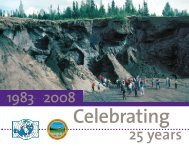Number 20, December 1996 - International Permafrost Association
Number 20, December 1996 - International Permafrost Association
Number 20, December 1996 - International Permafrost Association
- No tags were found...
Create successful ePaper yourself
Turn your PDF publications into a flip-book with our unique Google optimized e-Paper software.
perennial frost in the last 10 to <strong>20</strong> years in China are nowassuming greater importance. At the same time, Chinesescientists are increasingly aware of the Russian and NorthAmerican permafrost literature and the remedial and mitigationmeasures which are possible, but which have not yetbeen widely adopted in China. These circumstances wereexplicitly recognized by many speakers. It is refreshing tosee such vigorous activity in permafrost research in a countrywhere an appreciation of permafrost problems will playsuch an important role in improving the economic andsocial well-being of its people.Also of interest is the question of global change andpermafrost. This was specifically the theme of the openingplenary session entitled Cryosphere and Global Change, inwhich there were three keynote presentations: impact ofcryosphere variation on the environment (Cheng Guodong),glacier fluctuation (Tang Maocang), and effect of cryospherein climate change (Li Peiji). More specific information isprovided in several of the papers in the proceedings volume.For example, Li Shuxun reported that if the air temperatureon the Tibet Plateau increases at a rate of 0.04°C/yr, the extentof permafrost will initially reduce by approximately 30%.In another paper, Yao Tandong, Shi Yafeng and Yang Zhihongconcluded that all the ice cores obtained from westernChina, without exception, indicate climate warming duringthe <strong>20</strong>th century, and especially since the 1950s. Severalpapers dealt with other aspects of permafrost and global(climate) change. One reported on CH4 and C02 emissionson the Tibet Plateau, and several others on hydrologicaland glacier responses to climate change.A third component of the conference was a concern forenvironmental issues in permafrost regions, or regions ofdeep seasonal frost, and the initiation of studies involvingsatellite remote sensing (e.g. Analysis of Snow Cover on theTibet Plateau, by Li Zhen, Sun Wenxin and Zeng Qunzhu,and GIs techniques applied to permafrost data as illustratedby a poster display.The large number of papers and oral presentations bymembers of the Lanzhou Institute of Glaciology and Geocryologyreflects its overwhelming importance in such studiesin China. However, the impressive hcilities of Lanzhou University,with a student population in excess of <strong>20</strong>,000, andthe participation of academics, scientists and engineers fromagencies and universities outside of Lanzhou (e-g. PekingUniversity; Polar Research Institute of China, Shanghai;Deqing Oilfield Construction Design and Research Institute,Heilongjiang) indicate that permafrost research is widespreadthoughout China.A number of papers were concerned with snow hydrology,especially in Tibet, in glacierized basins, and from KingGeorge Island, Antarctica. But it seems likely that the greateststrength of current Chinese permafrost research lies inits theoretical studies of physical and mechanical properties.By contrast, relatively few studies described actual fielddata, site investigations or case studies, even. from Tibet.One is left with the distinct impression that this is a weaknessof current Chinese permafrost research. The impressivefield investigations of permafrost conditions in northeastChina and on the Qinghai-Xizang (Tibet) Plateau ofthe 1960s and 1970s apparently have not been continuedat that level of activity, even though LIGG has had a Qinghai-XizangPlateau Research Station at Golmud since theearly 1990s.In listening to the papers one recognizes a need for additionalmodern field instrumentation. Limited financial resources,and a preference for modern analytical and testingfacilities, may be the underlying causes of this .perceivedimbalance. What are required, as is true for most othercountries, are a number of long-term field data sets of eitherpermafrost conditions or engineering performance, inthis case from the Tibet Plateau and along the Qinghai-Xizang Highway.Cheng Guodong and Zhu Yuanlin are to be congratulatedfor organizing such a successful conference. Future conferenceswould benefit from more emphasis upon field studies,site investigation, and performance monitoring, as wellas field excursions.Submitted by Hugh M. FrenchPERMAFROST IN KAZAKSTANImmediately following the conference in Lanzhou, membersof the IPA Executive Committee (Brown, French andRomanovskii) accompanied by Stu Harris met in Almaty,Kazakstan, 21-30 August <strong>1996</strong>. The visit was arrangedjointly by the Institute of Geography, Kazakstan Academyof Sciences, and the <strong>International</strong> Center of Geoecology of.Mountain Countries and Arid Regions (ICGM). Its purposewas observation of permafrost and seasonal frost conditionsin the nearby mountains and evaluation of the potential forfuture research. Previous issues of Frozen Ground havereported on permafrost activities in Kazakstan; the publicationsof A.P. Gorbunov and associates are well-known.Prior to the dissolution of the Soviet Union, permafrostresearch and facilities in Kazakstan were directly under theSiberian Branch of the Academy of Sciences in Yakutsk.Following independence, the Institute of Geography of theKazakstan Academy of Sciences became the host organizationfor programs in permafrost, snow cover, glaciers, mudflowsand avalanches, but with close operational ties forFrozen Ground




